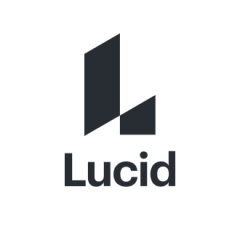What is our primary use case?
I'm using it for two purposes. One is internal brainstorming with team members inside of my own organization, and the other is external facilitation, in a consulting capacity, with our clients.
How has it helped my organization?
Just yesterday I led a session with some existing team members and some new team members, an onboarding session, to talk about what attributes make for a good client. It was really easy to have team members with more experience contribute more, and have team members with less experience see and learn from those contributions. And when it came to the distillation and sorting and aggregation of those ideas, everyone was able to contribute to those bigger-picture things.
Lucidspark definitely enables you to prioritize ideas and that is extremely important. The prioritization of ideas is one of the most important pieces of decision-making, and decision-making is a central function of any business. If you can't make decisions, you can't move projects forward. We're all trying to figure out how we make those decisions in a virtual space, without sharing an office together. This is a tool that has helped us do that.
It also enables you to spend more time discussing and revising ideas and next steps, and less time organizing them. I had no idea it was important to me until I knew that it was possible. Now that I know that it's possible, it has a lot of value. Any opportunity to get to the most important pieces and parts, such as what is the hardest question and what is the most challenging next obstacle—the sooner you can elevate them—the easier it is to get to the hard conversation.
Overall, Lucidspark is a vast improvement when it comes to the productivity of working and brainstorming sessions. Where we may have previously had folks respond to a static survey, with open-ended responses, it can now be a dynamic, crowd-sourced session with real-time contributions and improvements that may have otherwise never appeared. Or, if they did appear, they would have been in a follow-up meeting after a whole bunch of synthesis of those old survey results.
We also use Lucidchart and that was actually how I became aware of Lucidspark. The overall suite, for helping to visualize each step of the process, from brainstorming initial ideas, to turning those ideas into reality, is very good. I have used a lot of different chart-building tools in the past, in many different forms, but there are a lot of intuitive features in Lucidchart, inclusive of their templates. Those features make standard business process design and modification really easy, and really easy to convey to others who do not contribute to the creation of those documents. The ability to take a chart made with Lucidchart and use it in a Lucidspark environment is a really great opportunity to take what used to be one person writing down and designing a process, and turn it into allowing more people to contribute.
What is most valuable?
I have really enjoyed Lucidspark's virtual whiteboard. It is a big step up from some of the other tools that I have used. Not to be judgemental, but the Google Suite has a product called Jamboard and that is what we used previously. They are very different in their capabilities. I appreciate the robustness of Lucidspark quite a bit. It adds a lot more functionality when it comes to multiple participants, and I really appreciate that it is an expanding canvas. The limited size and shape of something like a Jamboard is not conducive to new ideas expanding, going further. I really like a lot of those features in the design.
I certainly have made a lot of use of the template library as well.
I also really enjoy the emoji reaction voting. That is a fun gamification of a pretty common feature for facilitation.
And the sorting and aggregating by color, or grouping, or contributor, are all also really helpful features. While the Collaborator Colors is a really nice feature to have, I could imagine a way to still use the tool without it.
Absolutely all of the work I've done with Lucidspark has been done when I've been in a different location than the other contributors. It meets the different needs of contributors, who may be less comfortable in an in-person environment, to be at a place where they have more ability to contribute, and I really appreciate that. It's not reliant on somebody speaking up because there are so many ways to contribute, without having to come off of mute on a Zoom call and say something out loud. Not everybody likes that version of contributing. It might make them feel anxious. The ability to just be able to type, or respond, or help with consolidating ideas into groups—any of those things are really easy for anyone in a session to do and to support. I've loved that.
What needs improvement?
One thing about the template library is that it does seem too focused on folks who develop SaaS products. There might be an opportunity for a little bit of an expansion for other, virtual, business-meeting-facilitation use cases, for folks who are not in the product development space.
In terms of its user interface and intuitiveness, it took a little bit of time to figure out the difference between the selection tool and the move-around tool. When I was able to figure out a few keyboard shortcuts, that helped a whole lot. Having those keyboard shortcuts a little more apparent or visible, in the early setup, as a new user is getting used to the platform, could help.
The one other significant recommendation is because I do work with folks outside of my organization quite regularly. The user experience of having them all have to set up a free account to join me in a workspace is a bit cumbersome. I really would love it if there was a Visitor link that would allow contributors who don't have free logins to join and participate.
For how long have I used the solution?
I've been using Lucidspark for just over a month.
What do I think about the stability of the solution?
I have had no outages, no glitches, or anything that would make me think that something in the solution is unstable.
What do I think about the scalability of the solution?
I would rate its scalability as very strong. I appreciated that when I dropped a link in Slack, it said, "Hey, we think this is a Lucidspark link. Do you want to download the Slack plugin?" I thought that was intuitive and helpful, given that we do so much of our day-to-day work in Slack already. If it talks to Slack nicely, that's a heck of an upgrade.
How are customer service and technical support?
I have not used technical support for Lucidspark.
Which solution did I use previously and why did I switch?
We selected Lucidspark because the existing work that we've done in Lucidchart is a huge component. We have a bunch of process and workflow documents that exist there, and team members who already have Lucidchart logins. Adding an additional license to access Lucidspark on top of that was really seamless and easy, once I found the button to start a Lucidspark session. That existing product that we already had was a huge foot in the door.
How was the initial setup?
The distinction between what components were in Lucidspark, such as the virtual white boarding component, and which ones were in Lucidchart, was a little tricky at the onset. Finding that it was truly in the "setup new template," and that that additional link was present, took me longer to find that I expected it to.
I've certainly received a good number of marketing materials and communications that are branded from Lucidspark. While the branding and the coloring allowed me to pretty clearly connect the dots that these two things were associated, when I clicked through on the link, the acknowledgement of what we currently had versus what we could have if we upgraded or added Lucidspark, was more confusing than I had anticipated. The way I overcame that was just a bunch of button-clicking and finding the dropdown that allowed me to start a Lucidspark canvas. Once I did, I said to myself, "Oh, it's here," and I could show my team exactly where it was. But prior to that, I was asking myself, "How do I get from this logo that says 'Lucidspark' and that is clickable, to doing something in Lucidspark?" because it always brought me to up my Lucidchart interface. I didn't know how to get around that.
Overall, the Lucidspark deployment took almost no time at all, except for that little kerfuffle of trying to figure out how to get to it.
I've shared it in our organization and folks have free logins, right now, to act as contributors. We have not done a full company deployment with paid user profiles for all members. I work on our client success team and that team has just over 10 people. In addition to them, I have shared it with our chief creative officer and one of our senior product designers and they are starting to work with the tool in their product teams.
What was our ROI?
We have absolutely seen return on investment from using Lucidspark because of the time savings.
What's my experience with pricing, setup cost, and licensing?
It's a very reasonable $8 a month. That makes it really accessible and helps it fill a pretty significant need for virtual collaboration. Just about every leadership team member that I've talked to said, “Oh, well, that's cheap, just go buy it."
Which other solutions did I evaluate?
I've used the embedded white boarding feature in both Microsoft Teams and in Zoom. They're rudimentary, but certainly better than nothing. The other product that I have spent the most time in is MURAL.
The connection between existing documents in Lucidchart and Lucidspark is a huge value-add, and I like that that ecosystem allows you to benefit from previous work inside of that suite. That's a great value.
MURAL's biggest thing—and it's actually where I had the inspiration for the recommendation for how Lucidspark could be improved—is that it does have a Visitor link. While working with clients, you don't need them to set up a free account to participate. That's a big thing. I could see a world where we continue to use Lucidspark internally, because it's really easy to have your employees set up logins and pay attention to them, and do client-facing work in MURAL because it's less cumbersome for the client. The teams overlap little enough that it would be very possible for them to do their specific work in each of those different silos. However, it would be another silo and it would be lovely if we did all of it in the same place.
In functionality, MURAL is very similar to Lucidspark. The templates that are available in MURAL are a little more advanced, and they cover a broader cross section of use cases.
What other advice do I have?
My internal resource sharing across our teams was a little silly and delayed. When I saw this solution I said to myself, “Oh, this might be helpful," and that was probably a backward way to go about it. It may make more sense for people to think about all of the possible use cases in their organization, or at least multiple use cases in their organization. I really did come to Lucidspark thinking about just the chair that I sit in, but it has a lot of applications outside of my own role. Ensuring that folks know about it and can benefit from it can take the productivity that you might get from one team doing this kind of collaboration, and spread it to a broader cross section of teams.
The solution has features to tag and automatically group and organize ideas after a brainstorming session, but I need to spend a little bit more time with them. We've primarily done manual sorting at this point. Part of that is a holdover from in-person facilitation. The sorting and aggregating component when you're in an actual conference room is just a part of the process, because there isn't a way to do that with sticky notes. I still rely on that a little bit as a facilitation point, and it means that I've just not leaned on the tools that are built-in, as much.
But the feature that I like the most in that context is the ability for individual contributors to link associated ideas when somebody else may have had a similar recommendation or suggestion. Having those little legacy trails, where two sticky notes have a line connecting them, is something that you just couldn't do in a physical space without tangling the entire conference room in yarn. This ability to automatically group ideas speeds up the ability to take action, a little bit, and I'm still getting used to whether our team is ready for, and desirous of, that speed. The main focus has not been the speed at which we can execute. It's been the consensus-building along the way. But overall, it does help. Using the tool to group and bundle ideas takes about half the time that it used to take.
Using the Lucidchart suite of products, I actually think of things such as moving ideas from the idea stage to execution as still occurring in other spaces, from an execution standpoint. We leave the sessions in Lucidchart and we're still going to databases and to our product. The groundwork and the alignment and expectation-setting and direction, from the work that's done in Lucidchart and Lucidspark, are incredibly valuable to ensuring the ability to do those other things, but I still do think of those other things as happening outside of the Lucidchart suite.
I really have enjoyed the product. It is filling a valuable gap in the market as we all transition, still nine months later in most places, to remote work. I am happy to have it.
Disclosure: PeerSpot contacted the reviewer to collect the review and to validate authenticity. The reviewer was referred by the vendor, but the review is not subject to editing or approval by the vendor.






